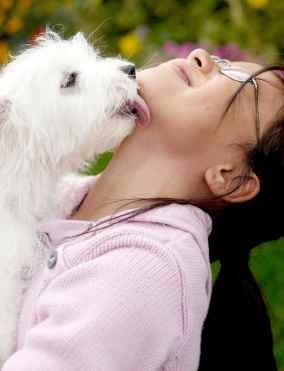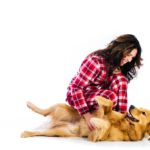It’s a common scenario for many dog owners: you’re petting your furry friend, showing them affection, and in return, they start licking you. While a little lick might seem like a sweet gesture, sometimes it can become excessive and even bothersome. If you’ve ever wondered, “Why Does My Dog Lick Me When I Pet Her?”, you’re not alone. Understanding the reasons behind this behavior is the first step to managing it effectively.
Dogs lick for a variety of reasons, and often, it’s their way of communicating and interacting with their world and with you. One of the primary reasons dogs lick is to show affection. Think of it as a doggy kiss. Licking can be a sign of love and bonding, mirroring how dogs groom each other within their pack. They may also lick you because they enjoy the taste of your salty skin or are drawn to scents on your hands from food or other things you’ve touched.
 Dog licking owner's hand while being petted, illustrating affectionate dog behavior
Dog licking owner's hand while being petted, illustrating affectionate dog behavior
However, sometimes licking can become excessive and may stem from other underlying causes. Dogs might lick when they are seeking attention. If your dog has learned that licking gets them attention from you, even negative attention like pushing them away, they may continue the behavior. In some cases, excessive licking can be related to anxiety or overstimulation. It can be a self-soothing behavior, much like a person might fidget or bite their nails when nervous. Over-excited dogs can also resort to licking as a way to release pent-up energy.
To manage your dog’s licking, especially if it becomes excessive, consistency is key. Everyone in the household needs to be on the same page regarding how to respond to licking. Decide as a family what level of licking is acceptable. Is a little gentle licking okay, or do you want to discourage it altogether? Mixed messages can confuse your dog and make it harder to change the behavior.
One effective technique is to manage the situation proactively. When you pet your dog, you can gently hold their collar or scruff to control their position and prevent them from reaching your face or hands to lick. If they still attempt to lick, a mild verbal correction like “No” or “Eh” can be effective. The key is to be gentle but firm, not harsh. You’re interrupting the licking behavior, not punishing your dog for showing affection. Continue petting them after the correction so they understand that you’re still happy with them, just not the licking.
Another approach is the “play hard to get” method. Give your dog attention only when they are calm and invited. Ignore attention-seeking behaviors like licking. This teaches your dog patience and that licking is not an effective way to get your attention. Make sure petting sessions happen when your dog is already in a relaxed state, as licking can sometimes be triggered by overstimulation.
For some dogs, especially puppies, providing a chew toy while petting can be helpful. This “pacifier technique” keeps their mouth busy and redirects their licking urge to the toy. It can be a useful tool for managing licking at any age.
Finally, consider your dog’s exercise levels. A tired dog is often a well-behaved dog. Lack of exercise can lead to pent-up energy and overstimulation, which can exacerbate licking issues. Ensure your dog is getting adequate physical activity appropriate for their breed and age. Often, addressing underlying needs like exercise can significantly reduce unwanted behaviors like excessive licking.
In conclusion, understanding why your dog licks you when you pet her involves considering various factors, from affection and communication to attention-seeking and anxiety. Managing this behavior requires consistency, gentle correction techniques, and sometimes addressing broader lifestyle factors like exercise. By taking a holistic approach, you can effectively manage your dog’s licking and strengthen your bond in a way that is comfortable for both of you.
